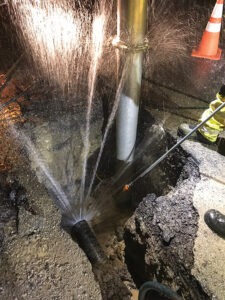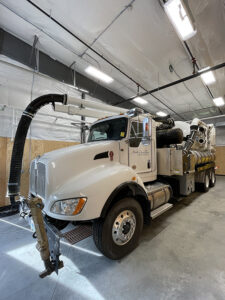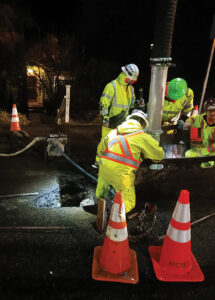When our weather changes from warm, dry summer days to the colder, rainy days of fall, these changes can cause our area’s soil to shift, sometimes dramatically when heavy rains come all at once.
This year the problem was exacerbated by a particularly hot, dry summer, with warm temperatures extending well into October, followed by a sudden shift to very cold temperatures in November.
When the soil shifts, whether from frozen water expanding and cracking, excess rain creating an underground sinkhole, or erosion in an adjacent area, the sudden lack of support can cause our water mains to break.

We at North City Water District strive to be as proactive as possible in identifying the potential for water main breaks in advance, through regular maintenance, physical inspections, and continuous system pressure monitoring, but it’s not possible to physically inspect every water main all the time.
That’s where proactive planning comes into play. We are constantly preparing for a variety of emergency and disaster responses; to us, a water main break provides excellent practice for what our crews may have to face on a larger scale, in the event of a major earthquake.

Broken water main caused by shifting underground conditions
When we are alerted to a water main break—whether from a customer who saw water on the ground, or heard water running, or a call from the fire or police department if a resident called them first—we quickly log into our computerized telemetry monitoring system (via remote access if it’s after hours / we’re away from the office).
Sometimes if the break is large enough, the telemetry monitoring system will notify us first via an alarm that senses pressure changes. This sophisticated system enables us to identify the location so our on-call employee can go out to investigate (our staff is available 24 hours a day, 7 days a week for emergencies).
Once a break has been confirmed, good communication is key to getting the repair made as soon as possible. Additional staff are consulted to determine how many crew are needed, what materials are required, and which equipment and vehicles will be necessary for the repair.

Our Vactor truck
Most repairs begin by digging away the earth, either by hand with shovels, by backhoe for larger breaks, or using a “vactor” truck—a large vacuum truck that can suck up the wet dirt and excess material around the break. When water main breaks affect our customers, our admin team posts notices to both Facebook and NextDoor to keep everyone informed of the process and estimated completion time.
We are extremely grateful for good equipment, good maps, and especially our amazing crew, including several long-time employees whose experience with our system enables them to come up with the most most effective and efficient plan to repair the damaged water main as quickly as possible.
Please Slow Down at Night
 Water main breaks don’t always occur during normal work hours, nor do they seem to take holidays off—as evidenced on Thanksgiving 2021, when a water main broke around 3:00 am, and our crews spent most of Thanksgiving day getting it repaired… thankfully just in time for the usual Thanksgiving dinner hour!
Water main breaks don’t always occur during normal work hours, nor do they seem to take holidays off—as evidenced on Thanksgiving 2021, when a water main broke around 3:00 am, and our crews spent most of Thanksgiving day getting it repaired… thankfully just in time for the usual Thanksgiving dinner hour!
When water main breaks happen at night, they pose extra danger to our crews.
Where possible, we have flaggers stationed before and after the affected area, which are fairly easy to see during daylight hours. However as soon as night falls, particularly in rainy weather, you may not see our flagger, much less any of our large equipment or staff working on the problem, until you come around a corner and confront them.
Please plan ahead on dark and/or rainy nights to allow some extra time to get to your destination.
Drive more slowly, and be alert to changes— those bright lights up ahead might be a crew of fathers, mothers, sons and daughters working after hours to keep your water running.
